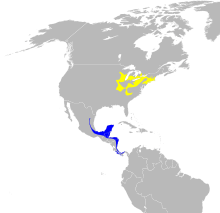Blue-winged warbler
| Blue-winged warbler | |
|---|---|
 | |
| Adult male in Maine, United States
Song | |
| Scientific classification | |
| Kingdom: | Animalia |
| Phylum: | Chordata |
| Class: | Aves |
| Order: | Passeriformes |
| Family: | Parulidae |
| Genus: | Vermivora |
| Species: | V. cyanoptera |
| Binomial name | |
| Vermivora cyanoptera Olson and Reveal, 2009 | |
 | |
| Range of V. cyanoptera
Breeding range Winter range | |
| Synonyms | |
|
Vermivora pinus | |
The blue-winged warbler (Vermivora cyanoptera) is a fairly common New World warbler, 11.5 cm (4.5 in) long and weighing 8.5 g (0.30 oz). It breeds in eastern North America in southern Ontario and the eastern United States. Its range is extending northwards, where it is replacing the very closely related golden-winged warbler, Vermivora chrysoptera.
Taxonomy
The common name blue-winged warbler refers to the bluish-gray color of the wings that contrast with the bright yellow body of the male. The name of the genus Vermivora means "worm-eating". The genus used to include nine other new world warblers but now includes only the golden-winged warbler and Bachman's warbler which is believed to be extinct.
The blue-winged warbler was one of the many species originally described by Linnaeus in his 18th-century work, Systema Naturae, though the scientific name has changed several times.[2] The species epithet Pinus was given by Linnaeus in 1766 but was a mistake as the original description of the species was actually based on illustrations of "pine creepers" drawn by others. The drawings depicted two different species, what we now call a pine warbler and blue-winged warbler. In 2010 the blue-winged warbler's scientific name was changed by the American Ornithologists Union to correct the error. Pine warblers retained the species name Pinus but the species epithet for blue-winged warbler was changed to cyanoptera.[3]
Hybridization with golden-winged warbler
This species forms two distinctive hybrids with golden-winged warbler where their ranges overlap in the Great Lakes and New England area. The more common and genetically dominant Brewster's warbler is gray above and whitish (male) or yellow (female) below. It has a black eye stripe and two white wing bars. The rarer recessive Lawrence's warbler has a male plumage which is green and yellow above and yellow below, with white wing bars and the same face pattern as male golden-winged. The female is gray above and whitish below with two yellow wing bars and the same face pattern as female golden-winged.
Description
The blue-winged warbler is a small warbler at 11.4–12.7 cm (4.5–5.0 in) long, with a wingspan of 17–19.5 cm (6.7–7.7 in). The breeding plumage of the male consists of a bright yellow head, breast and underparts. There is no streaking of the underparts of the bird. It has a narrow black line though the eyes and light blueish gray with two white wing-bars, which are diagnostic field marks.
The female is duller overall with less yellow on the crown. Immatures are olive green with wings similar to the adults.[4]
The song is a series of buzzing notes. The call is a sharp chip.
Distribution and habitat
Blue-winged warblers are migratory New World warblers. They winter in southern Central America and breed from east-central Nebraska in the west to southern Minnesota, Wisconsin, Michigan and southern Ontario in the north to central New York, southern Vermont, southern New Hampshire and New England to the east, south to western South Carolina, northern Georgia, northern Alabama, eastern Tennessee and southern Missouri.[4] It is a very rare vagrant to western Europe, with one bird wandering to Ireland.
The breeding habitat is open scrubby areas.
Ecology
Diet
Diet consists of insects, and spiders.
Reproduction
Blue-winged warblers nest on the ground or low in a bush, laying four to seven eggs in a cup nest. The females incubate the eggs for 10–11 days. The young are altricial and fledge in 8–10 days.[5]
References
- ↑ BirdLife International (2012). "Vermivora cyanoptera". IUCN Red List of Threatened Species. Version 2013.2. International Union for Conservation of Nature. Retrieved 26 November 2013.
- ↑ Linnaeus, Carl (1758). Systema naturae per regna tria naturae, secundum classes, ordines, genera, species, cum characteribus, differentiis, synonymis, locis. Tomus I. Editio decima, reformata. (in Latin). Holmia: Laurentius Salvius. p. 187.
- ↑ Chesser, R. Terry; Banks, Richard C.; Barker, F. Keith; Cicero, Carla; Dunn, Jon L.; Kratter, Andrew W.; Lovette, Irby J.; Rasmussen, Pamela C.; Remsen, J. V.; Rising, James D.; Stotz, Douglas F.; Winker, Kevin (2010). "Fifty-First supplement to the American Ornithologists' Union Check-List of North American Birds" (PDF). The Auk. The American Ornithologists’ Union. 127 (3): 726–744. doi:10.1525/auk.2010.127.3.726.
- 1 2 Terres, J. K. (1980). The Audubon Society encyclopedia of North American Birds. New York: Alfred A. Knopf. p. 967. ISBN 0-394-46651-9.
- ↑ Ehrlich, Paul R.; Dobkin, D.; Wheye, D. (1988). The Birders Handbook A Field Guide to the Natural History of North American Birds. New York: Simon & Schuster Inc. p. 500. ISBN 0-671-65989-8.
- Curson, Jon; Quinn, David; Beadle, David (1994). Warblers of the Americas: an Identification Guide. Boston: Houghton Mifflin. ISBN 0-395-70998-9.
External links
| Wikimedia Commons has media related to Vermivora cyanoptera. |
- Species account - USGS Patuxent Bird Identification InfoCenter
- Species account - Cornell Lab of Ornithology
- Stamps for Cuba - (incorrect range map pictured)
- Photo gallery - VIREO

